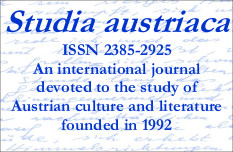Aporetische Architekturen. Der physiognomische Raum in Thomas Bernhards «Korrektur» (1975) und in der späten Philosophie Ludwig Wittgensteins
DOI:
https://doi.org/10.13130/1593-2508/4853Abstract
In Ludwig Wittgensteins’ Philosophical Investigations, physiognomy is used as a metaphor for the impenetrable boundary between the inner character and the outside appearance of language. In his novel Correction Thomas Bernhard confronts this concept of impenetrability with a specific production of architectural space. His protagonist Roithamer is consciously fighting against Wittgensteins boundaries of what is sayable. Both texts reflect the end of the long debates about physiognomics by reconsidering physiognomic thought as an aporetic but still productive hermeneutic tool.Dowloads
Pubblicato
Fascicolo
Sezione
Licenza
Licensed under a Creative Commons Attribution 4.0 International License
This journal allows the author(s) to hold the copyright without restrictions.
This journal allows the author(s) to retain publishing rights without restrictions.







